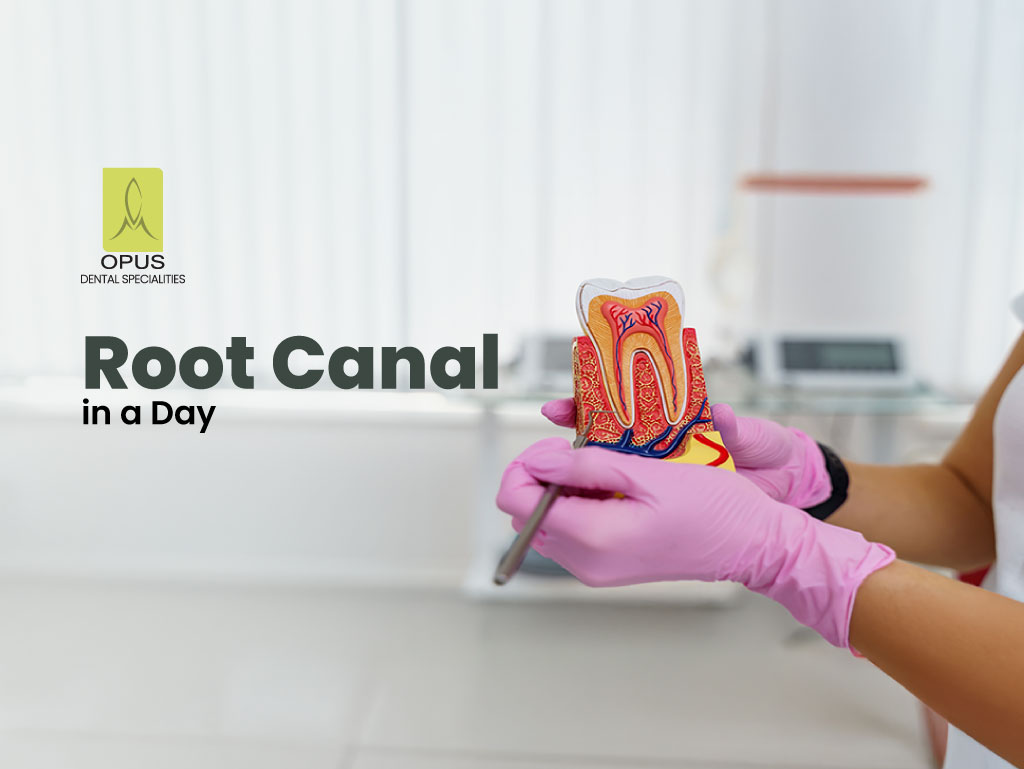
Toothaches are often ignored until they become unbearable. Whether it’s sensitivity, sharp shooting pain, or discomfort while chewing, the discomfort can disrupt sleep, mood, and daily life.
For years, root canal treatment (RCT) has been a go-to solution for saving a badly infected or decayed tooth. But the process traditionally took multiple visits—each with injections, drilling, and long chair time. Understandably, many people delayed or avoided it altogether.
Today, dental technology has changed the game. Single-sitting root canal treatment, often completed in just one visit, is not just possible; it is quickly becoming the preferred approach in many cases. But is it truly as effective and safe as traditional multi-visit root canals?
Let’s explore the truth behind this modern dental trend. Because no one wants to keep coming back for dental pain.
What Is a Root Canal Treatment, and Why Is It Needed?
A root canal treatment is performed when the soft pulp inside your tooth becomes inflamed or infected due to deep decay, repeated dental procedures, cracks, or trauma. This infection, if untreated, can spread to surrounding tissues and lead to swelling, bone loss, or even tooth loss.
RCT involves:
- Removing the infected pulp
- Cleaning and disinfecting the root canals
- Filling and sealing the space to prevent reinfection
The goal is to save your natural tooth and eliminate pain without the need for extraction.
How Is Single-Sitting RCT Different from the Traditional Approach?
Traditionally, root canal treatments were completed over two to three visits. Each session focused on cleaning, medicating the canal, and finally filling and sealing the tooth.
Single-sitting RCT condenses all these steps into one appointment, typically lasting 45 to 90 minutes, depending on the tooth’s condition.
The shift to one-visit root canals has been made possible due to:
- Advanced rotary instruments
- High-precision digital X-rays and imaging
- Better disinfecting solutions and techniques
- Faster and more durable filling materials
This means that what used to take multiple stressful visits can now often be completed in a single, efficient sitting.
When Is Single-Sitting RCT Recommended?
Not all cases are suited for single-sitting root canal therapy, but in many straightforward situations, it is a safe and effective option.
Ideal cases include:
- Teeth with early-stage pulp infections
- Teeth with no pus formation or swelling
- Non-complicated root canal anatomy
- Patients with busy schedules who want minimal disruption
- Emergency situations like accidental trauma or sudden pain
Your dentist will assess X-rays and perform diagnostic tests to determine if a one-day treatment is appropriate.
Benefits of Single-Sitting Root Canal Treatment
Faster treatment is only one advantage. There are several compelling reasons why both patients and dentists are opting for single-sitting RCT:
1. Time-Saving and Convenient
One of the biggest advantages of a single-sitting root canal is the time you save. Traditional root canals require multiple appointments spread over days or even weeks.
With single-sitting RCT, you complete the entire procedure in just one visit, freeing up your schedule. This is ideal for professionals, students, or anyone with a busy lifestyle. You spend less time in the dental chair and more time getting back to your normal life.
2. Reduced Risk of Infection Between Visits
When a root canal is stretched over several sessions, the temporary seal between visits can sometimes become contaminated. This re-entry of bacteria can lead to recurring infections or treatment failure.
A single-sitting RCT eliminates this risk by completing the cleaning, disinfecting, and sealing in one go. Your tooth is closed permanently on the same day, reducing exposure to outside pathogens. It also enhances the overall success rate of the treatment.
3. Improved Patient Comfort and Faster Relief
Enduring dental pain over several days is stressful, especially when each visit involves injections or discomfort. Single-sitting root canals quickly remove the infected tissue and seal the tooth, offering fast relief from pain.
This approach minimises the emotional and physical burden associated with ongoing dental treatment. For people with dental anxiety, fewer visits also mean fewer stress triggers. You walk in with pain, and walk out relieved.
4. Cost-Effective Over Time
Although the per-visit cost may be similar, single-sitting RCT can help you save on the overall treatment journey. Fewer visits mean fewer consultation fees, reduced travel expenses, and less time taken off work.
You also avoid any costs related to reinfections or missed follow-ups common in prolonged treatments. Over time, this efficient method proves to be economical without compromising on quality or outcomes. It’s a smart choice for both your health and wallet.
5. Better Patient Compliance and Completion Rates
Not everyone follows through with multiple appointments, especially if they start feeling better after the first one. This incomplete treatment can lead to reinfection or even tooth loss.
With a single-sitting root canal, the entire procedure is completed before the patient has a chance to miss follow-ups. It increases the likelihood of a full recovery and long-term tooth preservation. Compliance is automatic because everything is done in one smooth sitting.
Are There Any Risks with Single-Sitting RCT?
As with any dental procedure, success depends on correct diagnosis, technique, and aftercare.
Situations where multiple sittings may be necessary include:
- Presence of pus, abscess, or advanced infection
- Complex root canal structures (e.g., molars with multiple roots)
- Retreatment cases or previously failed RCTs
- Systemic health concerns like diabetes or immune disorders
Your dentist will evaluate your case and explain whether a single sitting is suitable or if a more cautious, staged approach is better. To separate fact from fiction when it comes to common Root Canal Myths, make sure you’re informed before making a decision.
Aftercare and Recovery
Regardless of the number of sittings, post-treatment care is crucial:
- Avoid chewing hard foods on the treated tooth for a few days
- Follow prescribed medications and pain relief
- Maintain excellent oral hygiene
- Schedule your crown placement if needed
A crown is often recommended after RCT, especially for back teeth, to protect the structure and restore full function.
Is Single-Sitting RCT the Future of Root Canal Therapy?
The trend is clear: more patients are seeking quicker, efficient, and more comfortable solutions for dental problems. When performed correctly by an experienced endodontist using advanced tools, single-sitting RCT is highly successful and safe.
However, the key lies in personalised treatment. Not every tooth is the same, and not every infection responds the same way. What’s important is having an honest conversation with your dentist, understanding your condition, and choosing the approach that ensures lasting results.
At Opus Dental Specialities, we combine advanced dental technology with compassionate care to bring you high-quality treatments, including single-sitting root canals tailored to your needs. Our expert team ensures that your experience is smooth, safe, and pain-free.
Book your appointment today and find out if single-sitting RCT is the right solution for your smile. Say goodbye to dental pain and multiple dental visits.
Also Read:
